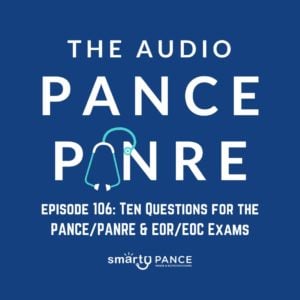Podcast Episode 106: Ten PANCE, PANRE, and Rotation Questions + Review of Adrenal Insufficiency
Description
Listen to Podcast Episode 106: Ten PANCE, PANRE, and Rotation Review Questions + Review of Adrenal Insufficiency
If you can’t see the audio player, click here to listen to the full episode.
 Welcome to episode 106 of the Audio PANCE and PANRE Physician Assistant/Associate Board Review Podcast.
Welcome to episode 106 of the Audio PANCE and PANRE Physician Assistant/Associate Board Review Podcast.
Join me today as we cover ten board review questions for your PANCE, PANRE, EOR, and EOC exams.
Links from today’s episode:
- Sign up for our new PANCE and PANRE Test Taking Masterclass
- Sign up for the Entire Blueprint Email Series
- Follow Smarty PANCE and The Daily PANCE Blueprint on Instagram and Facebook
- Review adrenal insufficiency and adrenal disorders
- Join the Smarty PANCE Member’s Community, then sign up for a study group to get updates about upcoming webinars.
I hope you enjoy this free audio component of the examination portion of this site. Smarty PANCE includes over 2,000 interactive board review questions, along with flashcards, ReelDx cases, integrated Picmonics, and lessons covering every blueprint topic available to all Smarty PANCE members.
- You can download and listen to past FREE episodes here, on iTunes, Spotify, Google Podcasts, Stitcher, Amazon Music, and all podcasting apps
- You can listen to all the latest episodes, take interactive quizzes, and download more resources on each episode page.
Interactive exam to complement today’s podcast
1. A 22-year-old female with an unknown past medical history presents to the ER with a prolonged seizure lasting more than 5 minutes per EMS. Her airway was supported, and IV access was obtained en route to the ER. Her blood glucose is 120. Her vitals are stable, and laboratory studies are relatively unremarkable. Which of the following would be an appropriate medication to give to this patient?
A. Calcium gluconate
B. Propofol infusion
C. Lorazepam
D. Clonidine
E. Narcan
The answer is C. Lorazepam
The patient has status epilepticus, which is defined as >5 minutes of continuous seizures or > 2 discrete seizures between which there is incomplete recovery of consciousness. Most episodes of status epilepticus in adults are due to a brain lesion or a toxic/metabolic disturbance (e.g., alcohol withdrawal, hypoglycemia, etc). Immediate management of status epilepticus includes stabilizing the airway, placing pulse oximetry and cardiorespiratory monitors, establishing IV access, and getting a glucose level. The first-line pharmacological agent given is a benzodiazepine (e.g., lorazepam or diazepam). Keppra, valproate, or other anti-seizure medication can be given as well.
Smarty PANCE Content Blueprint Review:
Covered under ⇒ PANCE Blueprint Neurology ⇒ Seizure disorders ⇒ Status epilepticus
Also covered as part of the Internal Medicine EOR and Emergency Medicine EOR topic list
2. A 41-year-old male presents to the ER after a construction accident that left him with severe right eye pain and decreased visual acuity. On a physical exam, you notice a teardrop-shaped pupil. Which of the following is the most likely diagnosis?
A. Globe rupture
B. Acute angle-closure glaucoma
C. Retinal detachment
D. Corneal laceration
E. Metallic foreign body
The answer is A. Globe rupture
Mechanical globe injuries occur when there is a laceration or full-thickness rupture through the cornea and/or sclera. Globe rupture (also called an open globe) follows blunt eye injury (e.g., motor vehicle crash, assault, thrown ball, etc). Globe lacerations occur after trauma from a sharp-penetrating object (e.g., knife or high-velocity projectile). PE signs include subconjunctival hemorrhage, irregularly-shaped pupil, hyphema (anterior chamber bleeding), decreased visual acuity, and limited EOM. This is an emergency and a patient should see an ophthalmologist immediately.
Smarty PANCE Content Blueprint Review:
Covered under ⇒ PANCE Blueprint EENT ⇒ Traumatic disorders ⇒ Globe rupture
3. A 45-year-old male veteran presents to your clinic complaining of the following for 4 months: problems with concentration, difficulty staying asleep, persistent negative state, inability to remember events that happened while he was in Iraq, feelings of detachment from others, avoidance of other veterans, and distress when seeing violence on the TV. He denies hallucinations. He has been a veteran for 5 years. Which of the following is the most likely diagnosis?
A. Acute stress disorder
B. Cyclothymic disorder
C. Brief psychotic episode
D. Derealization/depersonalization disorder
E. Post-traumatic stress disorder
The answer is E. Post-traumatic stress disorder
Post-traumatic stress disorder is a complex disorder defined by the behavioral, somatic, cognitive, and emotional effects of trauma. The most common causes are sexual relationship violence (33%), death or traumatic event of a loved one (30%), interpersonal violence like physical assault (12%), and participation in organized violence like combat (11%). The DSM-V criteria for PTSD is:
Exposure to a traumatic event(s). And then for ≥1 month of each of these that started/worsened after a traumatic event and are associated with the traumatic event:
1) Intrusion symptoms
2) Avoidance of stimuli
3) Alterations in cognitions and mood
4) Alterations in arousal/reactivity
Treatment is SSRIs + counseling/psychotherapy. About 50% of patients will recover in 3 months with treatment.
Smarty PANCE Content Blueprint Review:
Covered under ⇒ PANCE Blueprint Psychiatry ⇒ <a class="d







